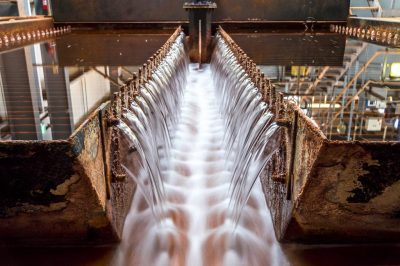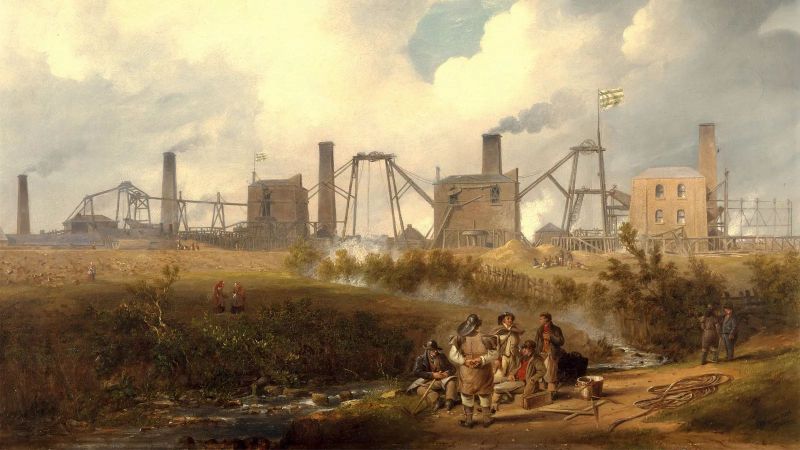For as much old coal mines are a blight upon the face of the Earth, they may have at least one potential positive side-effect. Where the coal mine consists out of tunnels that were drilled deep into the soil, these tend to get flooded by groundwater after the pumps that keep them dry are turned off. Depending on the surrounding rock, this water tends to get not only contaminated, but also warmed up. As the BBC explains in a recent video as a follow-up to a 2021 article, when the water is pumped up for decontamination, it can be run through a heat exchanger in order to provide heat for homes and businesses.

With the UK’s Coal Authority claiming that about a quarter of homes in the UK are located above coal fields, this might turn centuries of clean-up into an accidental source of low-carbon thermal power. One wine producing company – Durham-based Lanchester Wines – happened to have a large warehouse located right above four layers of flooded mine workings. After sinking a borehole into the murky depths of the old High Main coal seam, they were able to pump water at a balmy 15 °C out of the ground, that combined with a heat pump turned out to be capable of heating the company’s warehouses along with a range of other buildings.
As it turns out, other countries have been following a similar path, with Heerlen in the Netherlands using its old coal mines since 2008 to provide heat to local homes and businesses, along with taking in excess heat from e.g. data centers and storing this into the coal mine’s water. Similarly, Springhill in Novia Scotia already began a similar project in 1989, as has Spain’s Asturias region, with the latter starting its first geothermal project in 2018.
At its core, this is another example of district heating, which is not a new idea, but in many regions tends to get its thermal energy from fossil fuel plants. It also puts a positive spin on what is at its core an environmental disaster, as noted by the BBC. These mines naturally flood, which risks contaminating the local water table with heavy metals and kin, requiring constant pumping up of this water for filtering and disposal.

















15C isn’t exactly warm in the winter but it is better than freezing. Could help quite a bit with the hot water bill too.
Pretty sure this is used in combination with a heat pump.
15°C doesn’t sound like much, but combine it with a heat pump and you’ll get to 22°C, for a tiny fraction of the power needed to heat from 0°C to 22C in Winter with electric or coal.
It would be better than the 5 C that I use to keep my shop contents from freezing.
It’s about the same temperature you get from a ground loop heat exchange as used in heat pumps in the Tundra of Minnesota and similar frozen/drunken American states (e.g. Canada).
This whole deal is stupid. Ether the heat is just near surface temp or the cost of pumping the water will exceed the energy content. I smell someone’s grant application and an innumerate, credulous BBC reporter (is there any other kind?). Government tit suckers!
That’s before you start comparing the costs of decontaminating the water and pumping it around vs the cost of burying a loop in the garden. (The English can’t afford proper yards, pretend to like it that way.)
Can you read? The water needs to be pumped to be filtered to remove contaminants anyway.
The water at a depth of >800m is a lot warmer than 15 degrees, more like 40 degrees. I live near the project in Heerlen and it is quite successful. The old mine shafts are partially still there and in the beginning they had to figure out how to do it but it runs for quite a while now, without any problems.
I thought average temps a meter or two down were about 10-12C anyway, but I guess every little helps.
“For the most part, the temperature of groundwater in an area is equal to the year-round average air temperature of the surface.” – https://what-if.xkcd.com/132/
Unfortunately due to link rot, the original reference is no longer available
Ever hear of thw wayback machine ?
https://web.archive.org/web/20130301040812/http://www.ngwa.org/Fundamentals/studying/Pages/Groundwater-temperature's-measurement-and-significance.aspx
https://web.archive.org/web/20130525062942/http://www.epa.gov/athens/learn2model/part-two/onsite/ex/jne_henrys_map.html
It can be hotter or colder than the surface temperature depending on the time of year and depth.
https://protonsforbreakfast.files.wordpress.com/2012/01/amplitude-versus-time-versus-depth.jpeg
Our system at Vancouver Island University Nanaimo campus was installed in 2018.
https://falcon.ca/projects/vancouver-island-university-district-energy-system
Geothermal energy + heat pump + solar panels + batteries = $0 energy bill
Who cares about energy bills. TCO is what matters. If TCO is higher, equivalent CO2 will be too, because the people that will take your money will spend it in energy. And you’ll work harder to pay for it, producing more CO2
I get your point and mostly agree about TCO, but there is a difference if the money spent on energy is using fossil fuels or renewables, and companies selling solarcells and electric cars usually care more about the environment and will go further to reduce emissions and co2-compensate everything they do (since their customers care more), which indirectly funds research into reducing the TCO for technologies like solarcells and batteries since it is in the companies interest to do so.
>companies selling solarcells and electric cars usually care more about the environment and will go further to reduce emissions
You’re in for a rude awakening… CO2 compensation is basically the same as church indulgences. You pay to have a license to commit “sin”, and usually what you pay for isn’t even effective. It’s just clever bookkeeping, also known as “greenwashing”.
>which indirectly funds research into reducing the TCO for technologies like solarcells and batteries
The market goes to those who sell the cheapest, which is those who keep slimmer margins, which means those who spend the least on R&D. Technology development is not done at the level of the mass market – that is about balancing expansion and undercutting your competition. Countries like China are subsidizing old solar technology to keep the competition out of the market, which includes newer technology, so spending money on these things is not helping – it’s just throwing money out of your own country for pretend-environmentalism.
Battery development was funded by the laptop industry, later cell phones kicked in. Enabled electric car development 20 years later, which continues to drive battery dev.
Photovoltaics were economical before it was economical to put them on your roof.
You are confused between commodity markets and others.
For companies that decent engineers should want to work for the market goes to those that have the best product.
It’s only much later, when products are comparable that the lowest margin wins. e.g. Northgate had much lower margins than Apple. (But that’s another case, Apple products are Veblen goods. Overpriced ‘designer’ junk like a mechanical watch or Italian trash cars.)
TCO divided by system lifetime energy output = energy bill.
How can you say what TCO will be? Nobody can predict future energy prices. It is safe to assume that they will increase faster than inflation and that’s not something that you want to be participating in.
When you assume…
People have lost money making that bet. Long term trend is down for all commodities in healthy capitalist economies. There are bumps, but still. As the saying goes ‘the cure for $100 barrel oil is $100 barrel oil’. Yeah markets!
I’m sure there must be some low-grade coal left in the mines they’re flooding. As I understand it, one of the reasons you keep a coal mine dry is that water initiates methane/biogas production. I wonder if they’re using that resource.
Only takes a tiny amount of gas to make a mine explosive. Take a hell of a lot to be useful. And isn’t carbon neutral. Radioactive gases and toxic water are the other fun stuff.
As someone from close to Heerlen… the mine water heating project is riddled with problems and people who are hooked up to it have a long list of complaints of problems ranging from trouble to keep their house warm to very high energy bills. It is a bit unclear what is going to happen to it but there are talks of another 300M of investments in order to make it work properly… they are currently losing about 0.5M per month and people are not happy about it. There are also talks about (forcefully) hooking people up to the nearby Chemelot site for using heat from their industrial processes, but I know exactly zero people who are looking forward to that because of the trouble with the minewater project
Loosing? Sound’s like sour grapes.
Someone is ‘making’ 0.5M per month. Do you think they care about peoples houses being cold? That 300M is theirs already BTW, that’s what comes from ‘wise political contributions’. Grifters in government.
You can also generate energy by burning the coal in situ using pumped air and capturing the heat from the return. This lets coal seams that are otherwise uneconomical to mine be utilised. Alternatively, for remote seams, the coal can be gasified and the resulting gas captured for combustion off-site.
Together, these technologies could open up 2-3x as much coal as is available for conventional mining.
so Centralia actually had free heating. A pity they all relocated…
Not the best of ideas.
https://en.wikipedia.org/wiki/Centralia_mine_fire
I’m not sure that “blight upon the face of the Earth” statement is entirely fair to use when describing old coal mines… As the son of a former miner and past president of the NEIMME (google us) I would prefer that Coal mines be seen as an important part of the Industrial Revolution and part of my regions heritage.
“contaminating the local water table with heavy metals and kin,…”
I’ll bite: What the heck is ‘kin’? Google is no help, and I can’t figure out if it’s a typo.
I’m thinking Maya is using it like “family.” Kinfolk.
Could be read as “Heavy metals and stuff of that nature.”
Kin = family or relative. “heavy metals and related contaminants”
Grandparents home was above a real geothermal source (Cascade range in southern Oregon) that hads been (and likely still is) in place since the 1940s. They had a simple loop of pipe sunk into a borehole and convection carried it throughout radiators in the house and an exchanger for domestic hot water. No moving parts – it was glorious and quiet.
The tradeoff? Think about what’s under your feet that’s providing all that heat! (No eruptions yet though.)